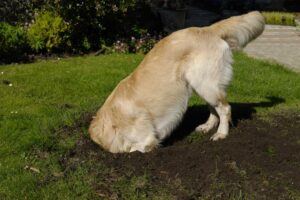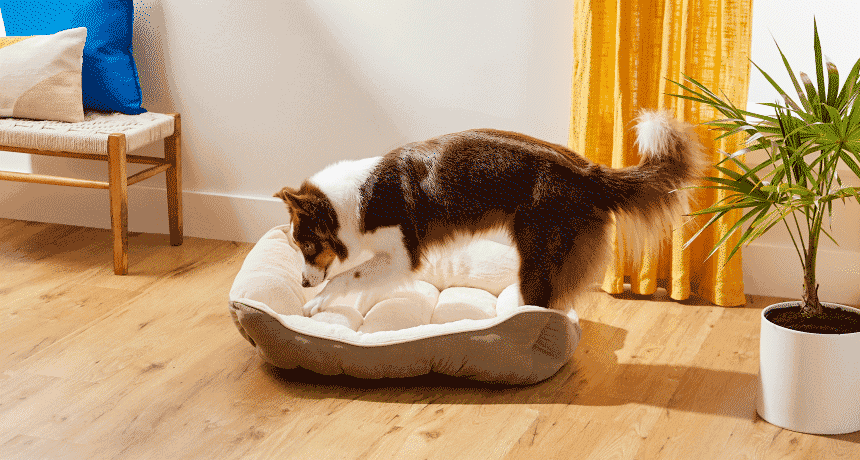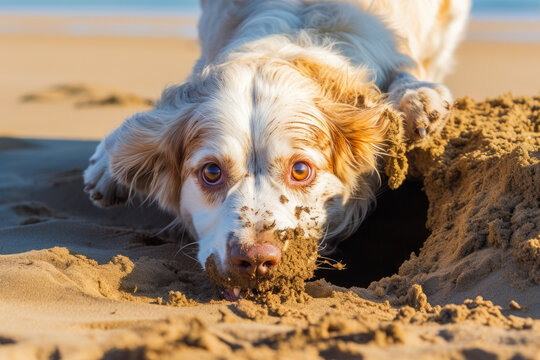 I’m going to kick things off by putting a spotlight on a behavior that’s as natural to dogs as wagging their tails – digging. From the moment they enter the world, puppies exhibit an innate curiosity that often expresses itself through their paws. They dig. Whether it’s in a garden, a pile of clothes, or the corner of a couch, their instinct doesn’t discriminate.
I’m going to kick things off by putting a spotlight on a behavior that’s as natural to dogs as wagging their tails – digging. From the moment they enter the world, puppies exhibit an innate curiosity that often expresses itself through their paws. They dig. Whether it’s in a garden, a pile of clothes, or the corner of a couch, their instinct doesn’t discriminate.
You’re going to find out about the reasons why our furry companions can’t seem to keep their paws out of the dirt. It’s not just about keeping themselves busy; there’s a spectrum of instincts and necessities driving this habit. And as they grow, this puppy pastime can morph into a full-blown hobby for adult dogs. What starts as a cute little quirk can sometimes turn your yard into a lunar landscape, or worse, wreak havoc indoors.
Understanding why your dog takes to the earth is crucial. It’s the first big leap towards finding a solution that keeps both of you happy. Whether it’s the sheer joy of the activity, a programmed response to hidden sounds, or a measure against extreme weather, each digging spree has its roots in a particular cause. And I’m here to help you unearth these causes.
Unearthing Reasons: Why Your Dog May Be Digging Holes
I’m going to let you in on a little secret: getting to the root of your dog’s digging habit starts with asking one simple question – why? Now, there’s more to it than just ‘dogs will be dogs.’ You’re going to find out about various underlying motivations that could explain why your furry friend has turned your backyard into a minefield.
First up is boredom, which ranks high on the list. Imagine being home alone all day with not much to do. That’s a one-way ticket to Dullsville for anyone, including your canine companion. If your dog doesn’t have enough physical and mental stimulation, those paws might just get itchy to dig. Look out for signs like excessive digging when left alone or if your dog doesn’t seem tired out after regular activities.
Then there’s the aspect of stress or anxiety. It’s not just about feeling nervous; it’s also about expressing that unease in a physical way. Think of digging as your dog’s method of channeling their energy when they’re not feeling quite right. Keep an eye out for other signs of discomfort, like pacing or whining, which could indicate your dog is digging to cope with their nerves.
Don’t forget the hunting instincts. This isn’t about your dog spontaneously deciding to become an archeologist; they might actually be responding to the sight or scent of burrowing critters. Your yard may be playing host to uninvited guests like moles or rabbits, triggering those hardwired predatory instincts in your pooch. You’ll notice this if your dog gets particularly focused and excited while digging in specific spots, often sniffing intensely before the action starts.
Lastly, temperature regulation can’t be overlooked. On hot days, dogs may excavate cool pits to lie in, and when it’s cold, they might dig tunnels as cozy retreats. If you see your dog frequently digging and lying in these holes during extreme weather, they’re likely trying to create a more comfortable resting spot.
This isn’t just a case of prohibiting your dog from digging; it’s about understanding and then tailoring your approach to each situation. In the next section, ‘Inhibiting the Impulse: Strategies to Redirect Digging Behavior,’ I’ll guide you through several tactics to help your dog ditch the digging. We’ll explore how to revamp your canine’s routine and introduce new toys and games designed to keep your dog engaged and satisfied—without turning your garden into a labyrinth of holes.
Inhibiting the Impulse: Strategies to Redirect Digging Behavior
You’re going to find out about practical strategies to gently steer your dog away from unwanted digging. Remember, this isn’t just about stopping a behavior; it’s also about understanding your furry friend and providing them with enriching alternatives.
Digging often stems from an excess of untapped energy. In my opinion, making sure your dog gets enough physical exercise is key. Regular walks, runs, or play sessions can go a long way to reduce the urge to dig.
Mental stimulation is just as crucial. Puzzle feeders, engaging toys like Kongs stuffed with treats, and toy rotation maintain interest and are fantastic boredom-busters. I really hope that these strategies will keep your pooch happily occupied and your garden intact.
When it comes to training, the ‘Leave it!’ or ‘No!’ commands are invaluable. Training your dog to respond to these cues gives you a reliable way to interrupt and redirect digging as soon as it starts. Consistency is essential; your first attempt doesn’t need to be perfect, but regular practice will yield impressive results.
Sometimes, compromise is the best strategy—I like to leverage the idea of a dedicated digging zone. A designated area like a sand or dirt box where your dog is allowed to dig can satisfy their digging instincts without ruining your lawn. This tactic acknowledges their natural behavior while setting clear boundaries.
Creating a Stress-Free Haven: Addressing Anxiety-Induced Digging
If you’ve observed your dog frantically digging more than usual, it’s possible they might be dealing with stress or anxiety. It’s vital to look beyond the behavior itself and figure out what’s troubling your furry friend. Your dog’s anxiety could stem from a variety of sources, including separation anxiety, noise phobias, or changes in the environment.
Once you pinpoint what’s causing distress, you’ll be better positioned to address it head-on. Maybe your dog needs a consistent routine to feel secure, or perhaps they need to socialized more to become comfortable with other pups and people. Changing up your routine to include more quality time together can often do wonders for an anxious dog.
In more severe cases, professional help may be the way to go. Getting advice from a trained behaviorist can be particularly beneficial. If you’re part of the TrustedHousesitters community, you have access to the Vet Advice Line, offering 24/7 support for any concerns you might encounter, including advice on managing your dog’s stress.
If you’re looking for some simple, at-home strategies, consider the environment you’re creating for your dog. Is it supportive and calming? Reading up on our expert guide about ‘six ways to calm an anxious’ dog can shed light on practical steps you can take. From soothing music to pheromone diffusers, there are a host of tools at your disposal to create a tranquil atmosphere for your dog.
Creating a stress-free environment will not only help curb the digging but can also lead to an overall happier and healthier pet. As the anxiety lessens, you’re likely to see a reduction in unwanted behaviors, including digging. This proactive approach to your dog’s emotional wellbeing not only solves the immediate problem but enhances the quality of your relationship in the long run.
The Holistic Approach: Adapting Environments to Deter Digging
Wrapping up, it’s clear that a one-size-fits-all solution won’t work for every dog’s digging dilemma. Your dog is an individual with unique needs, and understanding those needs is crucial to curbing their digging behavior. It’s not just about keeping your garden intact; it’s also about ensuring your furry friend’s well-being.
By adopting a holistic approach tailored to your dog’s environment, you’re acknowledging the impact of external conditions on their behavior. Whether it’s providing shady spots and cool rest areas during blistering summer months, or offering a warm, protected space when the mercury drops, your adaptability can make all the difference.
Remember that patience and consistency are key. It’s going to take time, and probably a bit of trial and error, to find out exactly what works for your dog. Adjustments might be necessary as you observe their responses, but that’s part of the journey you share.
Creating a comfortable environment for your pup goes a long way in preventing unwanted digging. It speaks volumes about your dedication as a pet parent. Looking ahead, keep learning, stay proactive about your dog’s needs, and remain open to new solutions as they come your way.
Your efforts to create a dig-free zone can help forge an even stronger bond between you and your pet. Embrace the challenge, and take pride in knowing you’re providing the best care possible for your digger. Most importantly, you’re enriching the life of your four-legged companion with every step you take together.

